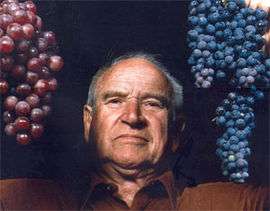Harold Olmo

Dr. Harold Olmo (July 31, 1909 – June 30, 2006) was a pioneering viticulturist and professor at the University of California, Davis where he created many new grape varieties known today as Olmo grapes. In the 1950s, he helped to establish California's first quarantine facility on the UC Davis campus to permit California growers to import foreign vines. This led to an expansion of California's wine industry as more Vitis vinifera was introduced to the area.
Career
In 1955, Professor of Viticulture at the University of California Harold Olmo was in Western Australia studying climatic limitations of viticulture in the Swan Valley. Olmo spent eight months in Western Australia at the invitation of the Western Australian Vine Fruits Research Trust.[1] When he published his report in 1956, one of the recommendations put forward was that Mount Barker and the Frankland of the Great Southern area of Western Australia showed great promise for making table wines in the light traditional European style.[2][1]
Olmo also developed more than 30 new grape varieties, including Ruby Cabernet, Carnelian, Rubired and Royalty.[3][4][5]
See also
References
- 1 2 Gladstones, John (2016). Viticulture and Environment (Revised ed.). Tanunda, South Australia: Trivinum Press. pp. ix. ISBN 978-0-9945016-1-5.
- ↑ "The Great Southern wine region history". Great Southern Wine Region History. Retrieved 2009-06-29.
- ↑ J Janick, James Troop Professor in Horticulture, Purdue University, USA, R E Paull, Department Chair, Professor of Horticulture, University of Hawaii at Manoa, USA (2008). The encyclopedia of fruit & nuts. CABI International. p. 918. ISBN 978-0-85199-638-7.
- ↑ Vitis International Variety Catalogue (VIVC) Royalty Accessed: August 17th, 2012
- ↑ J. Robinson Jancis Robinson's Guide to Wine Grapes pg 161 Oxford University Press 1996 ISBN 0198600984
External links
- Harold Olmo Papers at Special Collections Dept., University Library, University of California, Davis